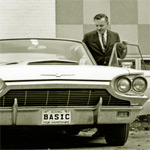Kemeny first learned about computers that could store data and programs at the same time from one computing's early pioneers, fellow Hungarian John von Neumann, at a 1946 lecture at Los Alamos. It sounded like science fiction, but Kemeny, who had crunched his share of numbers at Los Alamos, was fascinated. His first chance to use a computer came in 1953, and he was hooked. He had a prescient grasp of the impact computers would have on society, and he became determined to make it easy for students to access the new technology. This was a tall order at a time when the only computers available cost millions of dollars and used relatively difficult-to-learn languages. But Kemeny convinced the Dartmouth administration to make the investment. In 1963, he and math colleague Thomas Kurtz designed the first widely used "time sharing" system so that a single computer could simultaneously serve many users. The following year they wrote BASIC (Beginners All-purpose Symbolic Instruction Code) to allow those users to write programs easily. Dartmouth became the leader in accessible computing. SEE MORE: "The Computer and the Campus" (QuickTime movie) |
 
|
|||||||||||||||||||||||||||||||||||||||||
|
|
||||||||||||||||||||||||||||||||||||||||||